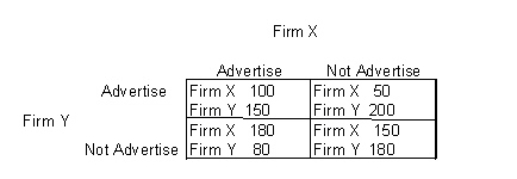A) there are few firms in the market.
B) the products produced cannot be easily differentiated.
C) entry and exit are both difficult.
D) firms spend a great deal on advertising and promotion.
E) firms spend very little on advertising and promotion.
G) A) and B)
Correct Answer

verified
Correct Answer
verified
Multiple Choice
Compared with generic products, a brand name:
A) reduces the price elasticity of demand and gives the firm more market power.
B) increases the price elasticity of demand and gives the firm more market power.
C) increases the price elasticity of demand and gives the firm less market power.
D) reduces the price elasticity of demand and gives the firm less market power.
E) has no effect on price elasticity of demand or market power.
G) A) and D)
Correct Answer

verified
Correct Answer
verified
True/False
Since only a few firms dominate the oligopoly market, cutthroat competition does not exist.
B) False
Correct Answer

verified
Correct Answer
verified
Multiple Choice
The following table shows the payoff matrix of the two firms (Firm X and Firm Y) in dollars when they advertise and when they do not advertise. Table 11.1  According to the Table 11.1, if the firms collude and decide not to advertise their combined payoff is:
According to the Table 11.1, if the firms collude and decide not to advertise their combined payoff is:
A) $250.
B) $260.
C) $330.
D) $300.
E) $280
G) All of the above
Correct Answer

verified
Correct Answer
verified
Multiple Choice
A most-favored customer is one who:
A) buys a firm's product regularly.
B) is an acquaintance of the owner of the firm.
C) is given the guarantee of receiving the lowest price for a product.
D) spends the maximum amount of money on a firm's product.
E) has a high purchasing power.
G) None of the above
Correct Answer

verified
Correct Answer
verified
Multiple Choice
If economic losses exist in a monopolistically competitive market,
A) new products will be introduced.
B) new firms will enter the market because they see potential for profit in the future.
C) firms will exit the market and the existing firms' demand curves will shift inward.
D) the average total cost curve must lie below the demand curve.
E) firms will exit the market and existing firms' demand curves will shift outward.
G) A) and B)
Correct Answer

verified
Correct Answer
verified
True/False
Both monopolistically and perfectly competitive firms earn only normal profits in the long run.
B) False
Correct Answer

verified
Correct Answer
verified
True/False
Suppose a monopolistically competitive firm is producing at the profit-maximizing output level and receiving a price that is sufficient to cover only its average variable cost.If the price falls further the firm should suspend its operations.
B) False
Correct Answer

verified
Correct Answer
verified
Multiple Choice
Advertising, brand names, packaging, and celebrity endorsements all occur in monopolistically competitive markets because:
A) significant barriers to entry exist in the real world.
B) in the real world, there are very few markets with many firms.
C) that gives the producer some command over the prices of their products.
D) product differentiation seldom occurs in the real world.
E) monopolistically competitive firms have an incentive to spend as much money as possible compared to their rivals.
G) B) and E)
Correct Answer

verified
Correct Answer
verified
Multiple Choice
Which of the following statements about the monopolistically competitive market in the long run is true?
A) The resources are efficiently utilized.
B) Consumers have a greater variety of products to choose from than under perfectly competitive market conditions.
C) The marginal-revenue curve coincides with the demand curve facing the firm.
D) The firms produce the output level that is less than the output corresponding to the minimum of average total cost.
E) The firms operate in the upward-sloping portion of the long run average cost curve.
G) B) and D)
Correct Answer

verified
Correct Answer
verified
Multiple Choice
In order to survive, cartels must be able to enforce contracts.However, when a cartel is trading in an illegal commodity:
A) it can use the judicial system to enforce contracts.
B) it relies on altruism of members to enforce contracts.
C) it is inherently stable because the market is underground.
D) violence becomes a means of contract enforcement.
E) authorities are effective in preventing the trade.
G) All of the above
Correct Answer

verified
Correct Answer
verified
Showing 101 - 111 of 111
Related Exams